Recent History of the White Rose Appearing in the Sueddeutsche Zeitung

This blog post is a translation of Jakob Wetzel’s article appearing on March 24, 2021 in Munich’s largest daily newspaper, the Sueddeutsche Zeitung (24.3.21, Nr. 69). It appears here with the permission of the SDZ. Reproduction of this translation requires permission and may be obtained by writing: read@booksonthepond.com
Translator’s note:
Sophie Scholl endures as key figure in Munich’s White Rose. She was executed seventy-nine years ago today (2.22.22). Remaining committed to a subject for close to twenty years has its advantages – one learns a lot about how history is recorded, re-recorded, used and in the Internet age, changed. I’ve always been very careful about my sources and fluent in German, had the distinct advantage of researching primary sources and even interviewing eyewitnesses including Sophie Scholl’s sister, Elisabeth Hartnagel (1920-2020) and Fritz Hartnagel’s son, Thomas.
The below article was published on the occasion of Sophie Scholl’s 100. birthday. It is written also as an experience of the city – and I remember visiting all of the places in search of my own feelings relating to each event that happened inside of these incredibly and ironically, beautiful buildings. Like Sophie, I was ecstatic to be living and studying at the University of Munich. Many of my contemporaries and colleagues could not understand how I could face this dark history every day, sometimes for hours, buried in archives. Yes, some days were incredibly rough. But I did not view Sophie Scholl’s life and death as tragedy. In her short time, living during some of humanity’s most inexplicable cruelty and insanity, she triumphed and her legacy endures and grows even brighter with time. What was it, then, that enabled her spirit to rise up? This is what made my work exciting. Sophie’s intellectual and religious journey compelled me forward – not the story of the buildings.
I also believe that Sophie Scholl’s relevance is due to her capacity to love, forgive and to write and this is the reason she endures as key figure in Munich’s White Rose. Her diary entries and letters to Fritz Hartnagel survived the war and will serve to illustrate an almost divine ability to live and even die, well. They may best be experienced by the English translation published by Little, Brown in the eighties.
I still read and study how this history is written and reported, ever watchful for any changes that must be added to my book. I am happy to report that Jakob Wetzel’s article contains all of the same facts that appear in “With You There Is Light”Â
-Alexandra Lehmann
Sophie Scholl’s Last Nine Months
In 1942, the resistance fighter, Sophie Scholl, arrived in Munich. In less than one year, Sophie will be executed after a show trial with the other resistors of the White Rose.
This year she would have been 100.
A Reconstruction
Who was Sophie Scholl? The resistance fighter against National Socialism counts as one of the most famous persons of German history. Her name stands for bravery, freedom, civil courage, and humanity. She and the White Rose have so much star power that for over a year their political likeness has been appropriated by extremists from the right and even to protest the Corona virus.
The true Sophie Scholl – or Sophia Scholl – as she was baptized, did not fight against a citizen’s duty to wear masks or the closing of stores and businesses. She fought against a dictatorship which killed millions. She did not, however, join in the resistance right away.
Born in 1921, Sophie was still a child as the Nazis came to power. She was originally convinced of the ideas from the National Socialist regime, like her older brother, Hans. But doubts eventually took hold. The Scholl family heard from neighbors about the murder of disabled and sick. Because they did not completely commit to the Hitler Youth and the League of German Girls, they are both temporarily arrested and imprisoned for ‘subversive activities’ in 1937.
When Sophie moved to Munich, she had for a long time, distanced herself from the regime. One year later she will be dead. At aged 21 she was executed by the National Socialists after a show trial which was supposed to give her death some kind of legitimacy. The students die by guillotine on February 22 in Stadelheim Prison.
On May 9, Sophie Scholl would be 100 years old. Because of this, the White Rose Foundation has curated a new traveling exhibition about her and her fellow resistors. From this Wednesday, one can see it by appointment at Sibling Scholl Dormitory, 7 Steinicke Place, Max-Vorstadt. After Easter, the traveling exhibit can be seen at the Sophie Scholl High School at Luitpoldpark, and afterwards at the Community Center in Ulm.
The Southern German Newspaper, Sueddeutsche Zeitung, remembers Sophie Scholl’s last nine months: from her arrival in Munich until her death.
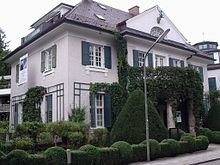
This is not Carl Muth’s villa but a representation of the architecture found in Solln, a suburb outside of Munich.
Villa Carl Muth
Sophie Scholl’s story in Munich began at Villenkolonie in Solln, far from the university in a place where the presence of the White Rose is hardly remembered. In May 1942, the then 21 year old Sophie Scholl moved out of Schwabia to Munich in order to study biology and philosophy.  It was already difficult to find an apartment. Sophie’s brother Hans, who had been studying medicine in Munich since 1939, helped his sister find a place to live. She found temporary lodging on Emil-Dittler Strasse 10, in the villa belonging to Carl Muth, the Catholic publisher. Here Sophie finds much more than just a roof over her head.
In 1903, Carl Muth first founded and published the Catholic culture magazine, “Hochland.†It was printed until April 1941 when it was criticized and then forbidden by the National Socialists. Four months later Hans Scholl met Muth; Scholl’s school friend, Otl Aicher, introduced the 23 year old student to the 51 year old publisher. Muth requested the obviously well read Scholl to sort his private library’s collection. For Hans, and for Sophie, Muth became a father like figure, discussion partner and mentor. Through him, they also met other thinkers that inspired them, including Theodor Haecker, whose work emphasized the disconnection between the Christian concept of a human being with that of the totalitarian, National Socialist idea of one. Many of his ideas can be found later in the White Rose’s leaflets.
Atelier Eickemeyer
This place exists now only in photographs. On Leopold Street, a few feet away from Jonathan Borosky’s “Walking Man†from Munich’s Ruck, several Jugendstil styled villas existed up until the Second World War, including number 38a where Manfred Eickemeyer had a studio. Hans Scholl met the architect in March 1942 through Carl Muth. Eickemeyer had worked in Warsaw, and told his young acquaintances about the atrocities he had seen in the Eastern occupied territories. He allowed his studio to be used as a meeting place.
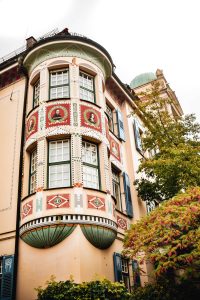
Jugendstil/Art Nouveau facades are a wonderful part of Munich. This is not Atelier Eickemeyer but may represent what his studio looked like.
Hans Scholl used this offer often. In early 1942, he and Alexander Schmorell, both students of medicine, organized readings in the studio. Scholl and Schmorell knew one another from the army’s student-medic company; Schmorell is the son of a Russian mother, and grew up Russian-Orthodox and sees those who resist the war as spiritually likeminded.
End of July and the beginning of August 1942, they formulated the first four editions of the White Rose. They made copies of them in the basement of the cellar and sent 100 to intellectuals. Sophie Scholl is probably already involved, as is Christoph Probst, a school colleague of Schmorell’s. Also Willi Graf, a medicine student from Kuchenheim in the Rhineland, joins too.
On July 23, 1942, Scholl, Schmorell and Graf are sent to the occupied eastern territories. The evening prior, they meet to say goodbye in Eickemeyer’s studio, Sophie Scholl is there, also Philosophy Professor Kurt Huber. They speak of their efforts needing to intensify after they return.
The Fence on Orleans Street
It is the most famous picture of the White Rose. On July 23, 1942, Scholl, Schmorell, and Graf among others will travel by train for three months to the East Front for further education and deployment. While they wait at Munich’s East Train Station, they speak to one another by the fence on Orleans Street. Sophie Scholl is saying good-bye, standing on the other side of the fence. She is wearing a daisy. George Wittenstein captures the moment with his camera.
One can see this photograph on a small commemorative plaque on the façade of a house on 61 Orleans Street. A larger commemorative plaque, that was not water proof, also stood here, but after 2017, it was removed. The fence’s days are numbered too. In 2028, a development called “Orleans Court†will be built.
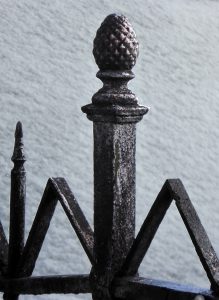
Deportations of the Jews living in Munich took place from Ostbahnhof, too.
This fence is worthy of history’s consideration. The journey to the front marked a turning point for the White Rose: here they changed their strategy. The first four leaflets were only sent to 100 recipients. In January 1943, they distributed more than a thousand copies of the fifth leaflet and addressed it to “To All Germans.â€
28 Mandl Street
As her brother left for the East Front, Sophie Scholl was no longer living with Carl Muth. After a few weeks she moved to Mandl Street in Schwabing. Here she sublet from Maria Loesch-Berrsche. It was not uncommon then to sublet a sublet. Sophie’s brother had lived previously in her room, who now lived at 13 Lindwurm Street. Later, after his return from the East Front, the two siblings shared an apartment at 13 Franz-Joseph Street. It is their last move.
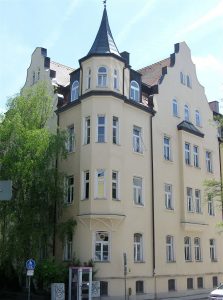
28 Mandl Strasse. Right near the gorgeous English Gardens.
After Sophie, her good acquaintances, Willi Graf and his sister Anneliese lived in the room at 28 Mandl Street. Willi Graf, in his earlier youth, like Hans Scholl, had stood in conflict with the Nazi regime: Scholl – accused of homo erotic relationships; and Graf, never entered the Hitler Youth and instead joined the Catholic Youth Group, the Grey Order, which was forbidden by the Nazis. Graf was jailed for two weeks for this transgression. Graf began his medical studies in 1937, and in 1940 he was drafted to the East Front, where he did not deny his witness of war crimes against civilians. In April 1942 he was allowed to study medicine in Munich.
He got to know Scholl and Schmorell in the medical student company, and took over the resistance group’s most dangerous assignment – recruiting others.
Franz-Joseph Street 13
Since the fall, the resistance activists had a new meeting place – Hans and Sophie Scholl lived in a two room apartment in a garden house on 13 Franz-Joseph Street. Today a commemoration plaque can be found on the front façade. Willi Graf and Alexander Schmorell were often guests here. They discussed the leaflets’ content and composition, and when it was too late, they stayed overnight in their friends’ apartment. Landlord Schmidt did not have a clue of what was happening as she stayed for weeks with her daughter in nearby Landsberg.
The White Rose Resistance became more radical and took more risks. The resistors formed a relationship with philosophy and music Professor Kurt Huber who lectured them at the university and instructed them privately. Together with Huber they wrote a leaflet, more than half a year after the fourth one. They copy more leaflets. In order to expand their network, they travel to other cities and distribute their leaflets in mail boxes. Lastly, on an evening in February, 1943, Scholl, Schmorell and Graf write “Down with Hiter!†and “Hitler is a mass murderer†and simply, “Freedom†on the façade of buildings in Munich’s Marienplatz, Viktualienmarket, and on Ludwig Street. In February, after the defeat of Stalingrad and a speech held by Munich’s Nazi Party Leader, they compose and copy their sixth leaflet. It is their last one.
Ludwig-Maximilians University
The last chapter of the White Rose begins in the foyer of the university. On the morning of February 18, 1943, Sophie and Hans entered it carrying suitcases full of leaflets. Later Sophie Scholl told the Gestapo Interrogators that they had carried between1,500 and 1,800 copies.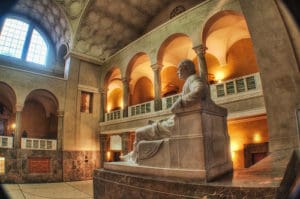
Siblings left piles of them in between various classrooms. Then, the famous and suspenseful moment – fueled perhaps by too much courage, Sophie pushed a stack of leaflets over the edge of the balustrade from the second floor and their leaflets drifted down into the foyer. A custodian stopped brother and sister and called the police. A few hours later Willi Graf and his sister are arrested. Because Hans Scholl was carrying another leaflet’s draft written by Christoph Probst, he will later be arrested in Innsbruck. Alexander Schmorell will flee, but will be arrested on February 24 when he is recognized in a Munich bomb shelter and turned in. Three days later, Kurt Huber will also be arrested.
Today at Ludwig-Maximilians University several memorials to the White Rose exist. The square of the main buildings is named after the resistance and since 1988, another memorial can be seen in front of the main entrance by artist Robert-Schmidt-Matt. In more places in the interior building, plaques to the “White Rose†in the foyer have been installed next to the organ. Above all, the White Rose Remembrance Center is the central place dedicated to the memory of resistance in Munich.
Wittelsbacher Palais
This building exists only in photographs. The Wittelsbacher Palace on the Brienner Street, was originally erected for the Bavarian royal family’s city residence. It was bombed in 1944 and was later destroyed. Today the Bavarian State’s Bank exists on this plot of land. Since 1984, the pre history of this site was remembered on a sign but became controversial because of its wording. Since 2012, however, an installation exists in its entrance.
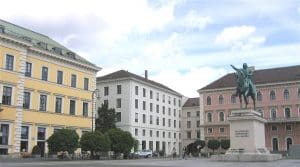
It records not the memory of the monarchy, but that of the center of the reign of the Nazi terror in Bavaria. In 1933 the Bavarian Political Police moved in, and later the Gestapo. In 1934, Reinhard Heydrich erected a prison with 22 cells in the northern part of the city that connected with the underground passages of the palace. In 1939, Georg Elser was questioned and murdered here. In 1943, the members of the White Rose were taken here. Willi Graf was interrogated for months. The Gestapo wanted to get the names of the other members from him. The siblings were here for only a few days. They were locked up on February 18. For three days they were apart from one another and questioned by Gestapo officers Anton Mahler and Robert Mohr. Sophie admits to everything immediately. Later, brother and sister attempt to assume all responsibility, to relieve the others, especially three time father, Christoph Probst. It is for naught. Four days later, with Probst, they are taken to a show trial to the Justice Palace.
Palace of Justice
The court’s proceedings took place in a room of Munich’s Justice Palace at 10 a.m. No proceedings take place at this site any longer.
Nazi Provincial leader Paul Giesler wants to make an example of Sophie and Hans Scholl and Christoph Probst and quickly. Roland Freisler, President of the so-called Peoples’ Court, traveled from Berlin in order to bring the accused to the gallows.
The lawyer is the mind of National Socialist “unjust justice; during the Nazi regime he oversaw the murder of 2,600 people. He judged the Scholl siblings and Probst as he did the others. Shortly before 1 p.m., he sentenced the three to death for inciting enemy action, preparation for treason and “Wehrkraft…â€
Eyewitnesses claim that Hans and Sophie Scholl took the sentence bravely as they reckoned with their death. Not Probst. He defended himself saying he was depressed. Against him was a draft of a leaflet. Freisler made no exception. He delivered the sentence of death by guillotine on the same day.
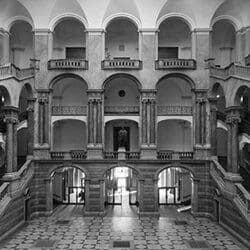
Eight weeks later Freisler returned to the Palace of Justice. On April 19, 14 of accused members of the White Rose stood before him, including Alexander Schmorell, Willi Graf and Kurt Huber. These three were also sentenced to death. In Room 253, where the sentence was given, is today a museum dedicated to the White Rose.
Stadelheim Prison
The justice branch in Munich-Stadelheim during the Nazi period was not only a prison, but a place of terror. Here, not only criminals were imprisoned here, but also political opponents of the regime. In 1942 it became the central hanging place for the Nazis in the southeast of the so called German Empire. One thousand, one hundred eighty eight people met their deaths behind the walls of this prison. Since 1973 they have all been memorialized in the prison entrance; since 2020 a commemoration was added outside of the prison – almost all of those executed were members of Munich’s resistance.
On February 22, 1943, Sophie Scholl also died here. She was 21 years old, her brother 24, and Christoph Probst, 23. Close to five months later, Alexander Schmorell (25) and Kurt Huber (49) were beheaded, and on October 12, Willi Graf (25). Professor Huber was buried in Waldfriedhof cemetery and the others in the cemetery by Perlacher Forst. Graf’s remains were taken in 1946 to Saarbruecken.
The Scholl siblings and Christoph Probst were taken from the Palace of Justice to the Stadelheim prison. At 4:00 p.m., Hans and Sophie received one last visit. It was their parents. The siblings were composed, Inge Scholl, their oldest sister, remembered. Probst was baptized Catholic; he did not see his wife or children again. At 5:00 p.m., the three friends were executed by guillotine. It took only seconds.